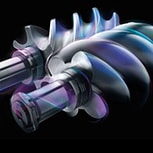
Making transmission lubricants
Challenges: To succeed in today’s market, your transmission lubricants must meet increasing demands for fuel economy and emissions reduction without sacrificing wear protection. Your customers also require durability, even fill-for-life capability in passenger vehicles, despite ever more challenging operating conditions. And the market is being shaped significantly by the needs of electric vehicles.
How we can help: Our advanced synthetic base stocks and world-class formulation expertise help transmission lubricant manufacturers meet the needs of today’s – and tomorrow’s – drivetrains. Transmission lubricant formulators rely on our synthetic base stocks to deliver higher performance and lower viscosity while providing exceptional oxidative stability, shear stability and low temperature performance, which enable longer drain intervals and energy efficiency.
Lubricant solutions
Electric vehicle (EV) driveline fluids

Automatic transmission fluids (ATFs)

Continuously variable transmission fluids (CVTFs)

Heavy-duty manual transmission fluids

Market trends
Increasing demand for fuel economy continues to impact the transmission lubricant market, as does the growth of electric vehicles.
1. Fragmented passenger vehicle market
Today’s passenger vehicle transmission market is fragmented, with preferred styles differing by region and even by areas within regions. These differences likely will continue in the near future. The largest EV presence is in Asia Pacific, with China leading global growth. We have seen large growth in dual-clutch transmissions (DCT) in China, while Japan still favors CVT. As automatic transmissions continue to dominate in the U.S., DCT popularity is growing in Europe, along with EV and hybrid vehicles.



2. Consolidated heavy-duty market
Unlike the fragmented passenger vehicle transmission market, the heavy-duty sector remains mostly unified. As the chart below makes clear, Class 8 transmissions account for more than 50% of global market share. More than 90% of Class 8 transmissions are manual or automated manual. Electrification is not expected for Class 8 in the near future, but we might see some growth in lighter commercial vehicles.

3. Synthetic lubricant growth
Despite the different styles, today’s drivetrains generally feature higher power outputs and more compact designs, with lower oil volumes in circulation. Higher temperatures are exceeded only by higher customer expectations for energy efficiency, wear protection and fluid durability. To meet these challenges, formulators are turning to synthetic base stocks, and forecasts see this trend continuing. The chart shows that while total lubricant growth will be limited, synthetics growth will be robust.



Inside insights
Explore ways we can help your business.
-

Suite of solutions
Explore the formulation and performance advantages provided by our suite of advanced synthetic base stocks
Learn more
-

Investing in reliable supply
Through significant investment in global synthetic base stock capacity expansion, we can deliver what you need where and when you need it.
Learn more -

Synovation video – Synthetic vs. mineral base stocks
Find out the distinct performan ce advantages synthetic base stocks provide over mineral-oil base stocks
Watch the video













